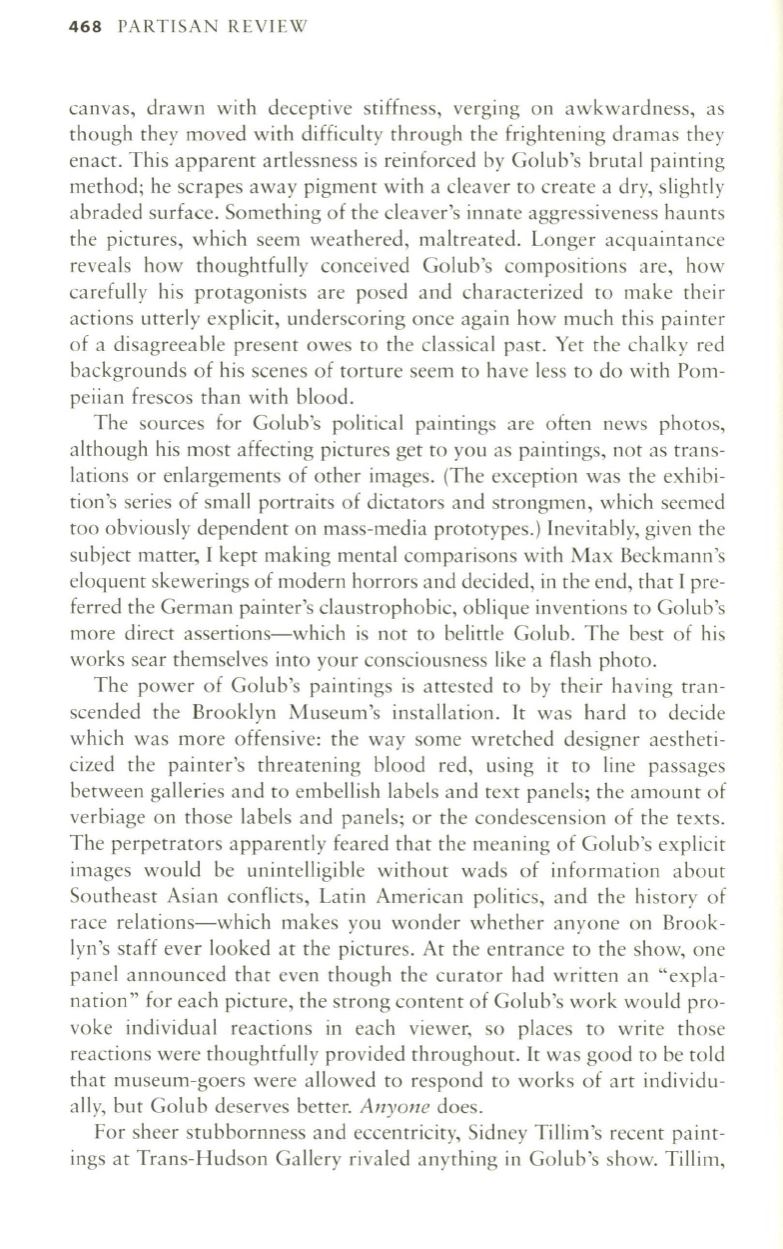
468
PARTISAN REVIEW
canvas, drawn with deceptive stiffness, verging on awkwardness, as
though they moved with difficulty through the frightening dramas they
enact. This apparent artlessness is reinforced by Golub's brutal painting
method; he scrapes away pigment with a cleaver to create a dry, slightly
abraded surface. Something of the cleaver's innate aggressiveness haunts
the pictures, which seem weathered, maltreated. Longer acquaintance
reveals how thoughtfully conceived Golub's compositions are, how
carefully his protagonists are posed and characterized to make their
actions utterly explicit, underscoring once again how much this painter
of a disagreeable present owes to the classical past. Yet the chalky red
backgrounds of his scenes of torture seem to have less to do with Pom–
peiian frescos than with blood.
The sources for Golub's political paintings are often news photos,
although his most affecting pictures get to you as paintings, not as trans–
lations or enlargements of other images. (The exception was the exhibi–
tion's series of small portraits of dictators and strongmen, which seemed
too obviously dependent on mass-media prototypes.) Inevitably, given the
subject matter, I kept making mental comparisons with Max Beckmann's
eloquent skewerings of modern horrors and decided, in the end, that I pre–
ferred the German painter's claustrophobic, oblique inventions to Golub's
more direct assertions-which is not to belittle Golub. The best of his
works sear themselves into your consciousness like a flash photo.
The power of Golub's paintings is attested to by their having tran–
scended the Brooklyn Museum's installation.
It
was hard to decide
which was more offensive: the way some wretched designer aestheti–
cized the painter'S threatening blood red, using it to line passages
between galleries and to embellish labels and text panels; the amount of
verbiage on those labels and panels; or the condescension of the texts.
The perpetrators apparently feared that the meaning of Golub's explicit
images would be unintelligible without wads of information about
Southeast Asian conflicts, Latin American politics, and the history of
race relations-which makes you wonder whether anyone on Brook–
lyn's staff ever looked at the pictures. At the entrance to the show, one
panel announced that even though the curator had written an "expla–
nation" for each picture, the strong content of Golub's work would pro–
voke individual reactions in each viewer, so places to write those
reactions were thoughtfully provided throughout.
It
was good to be told
that museum-goers were a llowed to respond to works of art individu–
ally, but Golub deserves better.
Anyone
does.
For sheer stubbornness and eccentricity, Sidney Tillim's recent paint–
ings at Trans-Hudson Gallery rivaled anything in Go lub 's show. Tillim,


